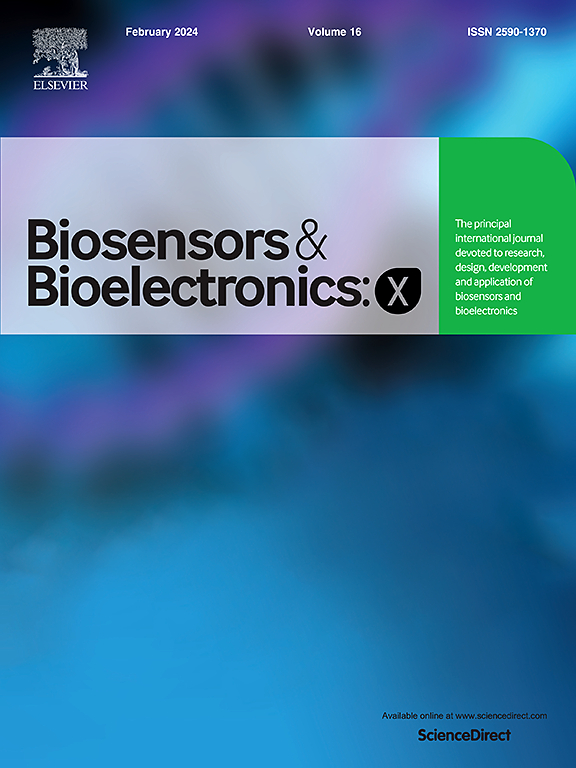CIRCA: Circadian inference of rhythmicity using comparative analysis from non-invasive continuous measurements of cortisol and melatonin in passive perspiration
IF 10.61
Q3 Biochemistry, Genetics and Molecular Biology
引用次数: 0
Abstract
Cortisol and melatonin exhibit distinct circadian rhythms crucial for the regulation of stress and sleep-wake cycles. Precise and continuous evaluation of differential rhythmicity is essential for understanding and managing circadian health; however, current methods using salivary samples are inconvenient for continuous use and dynamic monitoring. In this work, we demonstrate the continuous and dynamic monitoring of cortisol and melatonin using a sweat based wearable sensor based on passive perspiration. Salivary levels mapped with sweat concentrations at sample collection times exhibited strong relationships (Pearson r = 0.92 for cortisol and r = 0.90 for melatonin), and Bland-Altman analysis verified matrix agreement (mean bias close to zero with narrow limits of agreement of −6.09 to 5.94 ng/mL for cortisol and −7.54 to 10.77 pg/mL for melatonin). CircaCompare was used to establish differential rhythmicity, and the results showed two separate peak phases: melatonin at 2AM and cortisol at 8AM when aggregated for all subjects; however, the phases and amplitudes shifted when the results were analyzed by age and by sex validating the dynamic expressions vary by subject and the importance of continuous monitoring of these circadian biomarkers. This study is the first to demonstrate that a passive perspiration based biosensing that continuously measures cortisol and melatonin would help stratify age-related and potentially environment/life-style related changes in hormonal phase and amplitude expression of the circadian biomarkers. Our research establishes sweat as an effective alternative to saliva for endocrine monitoring, facilitating tailored circadian health management, wearable chronotherapy, and continuous hormonal diagnostics.
CIRCA:利用被动排汗中皮质醇和褪黑激素的无创连续测量的比较分析来推断节律性
皮质醇和褪黑激素表现出独特的昼夜节律,对调节压力和睡眠-觉醒周期至关重要。精确和连续地评估差异节律对于理解和管理昼夜健康至关重要;然而,目前使用唾液样本的方法不方便连续使用和动态监测。在这项工作中,我们展示了使用基于被动排汗的汗液可穿戴传感器连续动态监测皮质醇和褪黑激素。唾液水平与汗液浓度在样本采集时间的映射显示出很强的相关性(皮质醇的Pearson r = 0.92,褪黑激素的r = 0.90), Bland-Altman分析验证了矩阵一致性(平均偏差接近于零,皮质醇的一致性范围为- 6.09至5.94 ng/mL,褪黑激素的一致性范围为- 7.54至10.77 pg/mL)。circaccompare被用来建立不同的节律性,结果显示两个不同的峰值阶段:当所有受试者聚集在一起时,褪黑激素在凌晨2点和皮质醇在早上8点;然而,当按年龄和性别分析结果时,相位和振幅发生了变化,验证了动态表达因受试者而异,以及持续监测这些昼夜节律生物标志物的重要性。这项研究首次证明,一种基于被动汗液的生物传感技术可以持续测量皮质醇和褪黑激素,这将有助于分层与年龄相关和潜在的环境/生活方式相关的昼夜节律生物标志物的激素阶段和振幅表达的变化。我们的研究确立了汗液作为内分泌监测的有效替代唾液,促进量身定制的昼夜健康管理,可穿戴计时疗法和持续的激素诊断。
本文章由计算机程序翻译,如有差异,请以英文原文为准。
求助全文
约1分钟内获得全文
求助全文
来源期刊

Biosensors and Bioelectronics: X
Biochemistry, Genetics and Molecular Biology-Biophysics
CiteScore
4.60
自引率
0.00%
发文量
166
审稿时长
54 days
期刊介绍:
Biosensors and Bioelectronics: X, an open-access companion journal of Biosensors and Bioelectronics, boasts a 2020 Impact Factor of 10.61 (Journal Citation Reports, Clarivate Analytics 2021). Offering authors the opportunity to share their innovative work freely and globally, Biosensors and Bioelectronics: X aims to be a timely and permanent source of information. The journal publishes original research papers, review articles, communications, editorial highlights, perspectives, opinions, and commentaries at the intersection of technological advancements and high-impact applications. Manuscripts submitted to Biosensors and Bioelectronics: X are assessed based on originality and innovation in technology development or applications, aligning with the journal's goal to cater to a broad audience interested in this dynamic field.
 求助内容:
求助内容: 应助结果提醒方式:
应助结果提醒方式:


